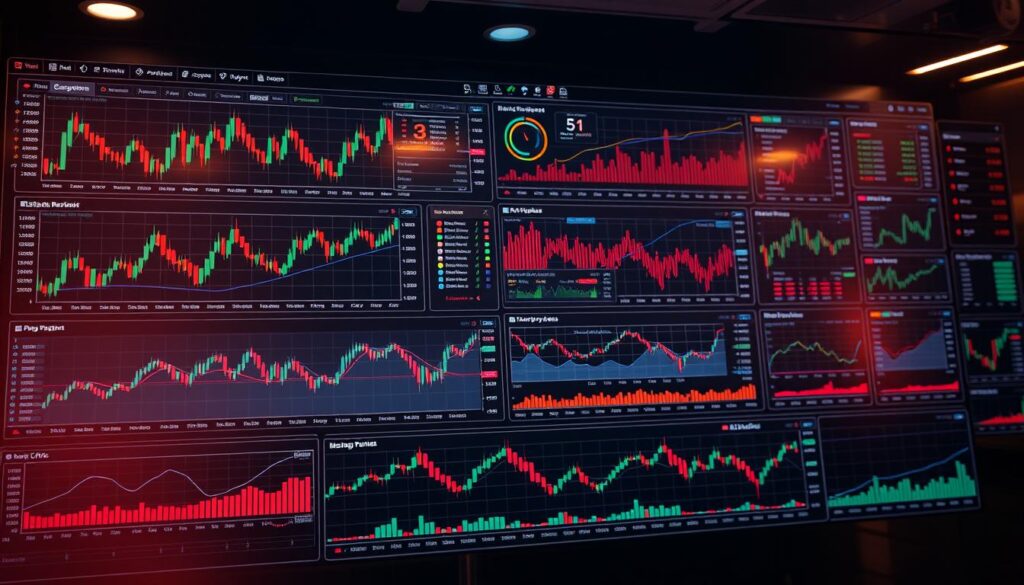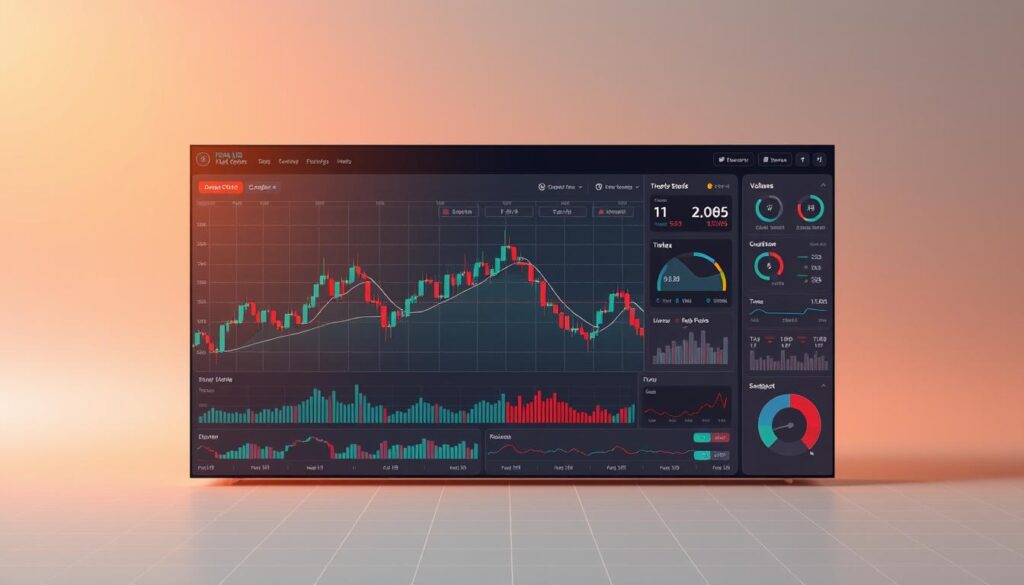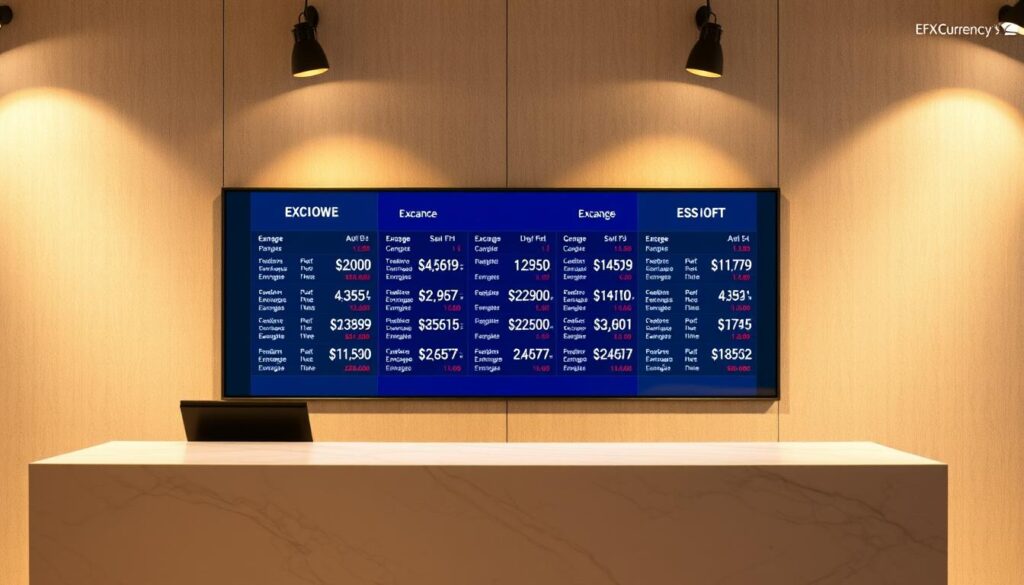The S&P 500 index serves as a cornerstone of global financial markets, representing five hundred leading U.S. companies. Tracking this benchmark since 1993, the SPDR S&P 500 ETF (SPY) offers investors exposure to diversified market performance through a single, liquid asset. Analyzing its movements requires tools that combine precision with accessibility.
Modern platforms empower traders to decode complex market patterns using advanced charting features. These systems provide real-time data visualization, enabling users to spot trends, test strategies, and make informed decisions. What once required institutional resources now sits at every investor’s fingertips.
For those monitoring the S&P 500 index, understanding price action goes beyond basic line graphs. Interactive tools allow deep dives into historical comparisons, volatility measurements, and sector-specific breakdowns. This level of analysis helps demystify market behavior, whether for short-term trades or long-term portfolio management.
Since its launch, SPY has become a bellwether for U.S. equity markets. Pairing its reliability with cutting-edge analytical capabilities creates opportunities for traders at all experience levels. The right platform transforms raw data into actionable insights, bridging the gap between market observation and strategic execution.
Introducing the Spy TradingView Service
Analyzing price trends in major indices has never been more accessible. This platform merges live financial data with intuitive tools, offering traders a clear view of the market. With SPY currently trading at $642.47 and managing $645.38 billion in assets, the service delivers critical insights for navigating large-cap stocks.
The system aggregates real-time price updates, volume metrics, and institutional activity into one dashboard. Users gain instant access to fund flow patterns, including the $4.93 billion influx recorded over the past year. This data-rich environment helps identify emerging opportunities while managing risk.
Novice and experienced traders alike benefit from the collaborative features. Shared charts and strategy ideas create a knowledge-sharing ecosystem, simplifying complex market analysis. Customizable alerts keep users informed about critical price movements without constant monitoring.
By combining institutional-grade tools with an approachable design, the service bridges the gap between raw data and actionable decisions. Whether tracking short-term fluctuations or long-term trends, it provides the clarity needed in today’s fast-paced markets.
Unpacking Advanced Charting and Analysis Tools

Modern trading platforms transform complex data into actionable insights through advanced visualization. Sophisticated chart systems let users dissect market movements with surgical precision, combining multiple analytical layers for comprehensive reviews.
Interactive Chart Features
Dynamic interfaces allow traders to adjust timeframes from minutes to decades in one click. Three core capabilities stand out:
- Multi-tool overlays for comparing price action with volume trends
- Drag-and-drop zoom functions for examining specific market events
- Side-by-side comparisons of different asset classes
These features help identify recurring patterns while filtering out market noise. Real-time updates ensure every analysis reflects current conditions.
Customization of Technical Indicators
Traders can build personalized dashboards using 100+ preloaded metrics or custom formulas. Popular combinations include:
- Moving averages paired with Bollinger Bands®
- RSI oscillators combined with MACD histograms
- Volume-weighted price levels with Fibonacci retracements
The system automatically highlights key support zones and resistance thresholds. Saved templates maintain consistency across analyses, whether tracking intraday swings or quarterly trends.
Real-Time Data and Market Trends Overview

Market participants rely on timely information to navigate volatile conditions. Access to instantaneous data streams transforms how investors spot opportunities and manage risks in equity markets.
Live Price Updates and Trading Dynamics
The price of major funds shifted 1.16% upward over the last month, reflecting changing investor sentiment. Real-time tracking tools capture these movements through:
- Millisecond refresh rates for bid-ask spreads
- Custom alerts for threshold breaches
- Volume heatmaps showing liquidity patterns
These features help traders identify momentum shifts as they unfold. The 2.60% increase in net asset value this month demonstrates how rapid data processing supports timely decisions.
Historical Performance Insights
Long-term analysis reveals patterns that short-term charts might miss. Over the past year, benchmark funds showed 14.82% growth alongside 16.46% NAV improvements. Three key benefits emerge from historical reviews:
- Identifying seasonal trends across market cycles
- Comparing current volatility to past extremes
- Assessing recovery speeds after corrections
Combining these insights with live data creates a powerful framework for strategy development. Investors gain perspective on whether recent gains signal sustained growth or temporary spikes.
Exploring spy tradingview for Better Investment Decisions

Modern investors face critical questions when navigating fast-paced markets. Advanced analytical platforms transform complex data into clear action plans, combining technical indicators with real-time news feeds. This multi-layered approach helps traders assess market sentiment and timing with precision.
Fund flow metrics reveal powerful insights for strategic moves. The $4.93 billion流入 into SPY over the past year signals strong confidence from both institutions and retail participants. Traders use this data to gauge whether to increase exposure or secure profits during volatility.
Three key features enhance decision-making processes:
- Integrated social sentiment trackers highlighting emerging trends
- Screening tools that cross-reference technical patterns with volume spikes
- Historical backtesting for validating strategies before live execution
These capabilities allow investors to balance quantitative analysis with market intuition. Real-time alerts on sector rotations or unusual options activity add depth to risk management plans. By merging diverse data streams, traders craft adaptable strategies for shifting markets.
The platform’s strength lies in simplifying complex relationships between indicators and price action. This clarity helps users identify high-probability trades while avoiding emotional decisions during turbulent sessions.
SPY ETF Fundamentals and Key Metrics
Understanding core financial metrics helps investors evaluate long-term potential. This exchange-traded fund combines scale, efficiency, and stability – three pillars supporting its dominance in global markets.
Assets Under Management and Dividend Yield
With $645.38 billion in assets, this fund ranks among the world’s most liquid investment vehicles. Its massive size ensures tight spreads and seamless execution for traders. The 1.11% dividend yield provides consistent income while maintaining growth exposure.
Key advantages include:
- Institutional-grade liquidity for large transactions
- Quarterly distributions aligned with index components
- 30-year operational history across market cycles
Expense Ratio and Fund Flows Analysis
The 0.09% annual fee makes this one of the most cost-efficient funds available. Investors save thousands compared to actively managed alternatives over decades. Recent $4.93 billion inflows confirm strong market confidence.
Tax considerations impact net returns:
- Short-term gains taxed at 39.60%
- Long-term holdings qualify for 20.00% rate
- Dividends taxed as ordinary income
These metrics demonstrate why the fund remains a cornerstone of diversified portfolios. Its combination of low costs and reliable performance attracts both new investors and seasoned professionals.
Technical Analysis: Oscillators, Moving Averages, and Beyond

Technical indicators serve as compasses for navigating market volatility. Oscillators like RSI and MACD measure momentum through mathematical formulas, identifying potential turning points. Current readings hover in neutral territory, suggesting balanced conditions without extreme overbought or oversold pressures.
Moving averages cut through market noise to reveal underlying trends. Traders often layer multiple periods – 50-day and 200-day lines – to spot convergence patterns. Three key applications emerge:
- Identifying support/resistance levels during price pullbacks
- Confirming trend strength through slope angles
- Spotting golden crosses (bullish) or death crosses (bearish)
While current oscillator signals remain neutral, buy recommendations emerge from multi-timeframe analysis. Shorter periods show stronger bullish bias compared to weekly charts. This divergence highlights the importance of context – a 4-hour chart’s strong buy signal carries different weight than a monthly view.
Advanced practitioners combine these tools with volume analysis and chart patterns. The neutral signals in primary indicators suggest cautious optimism rather than clear directional bias. By cross-referencing multiple data points, traders build conviction before executing positions.
Understanding the S&P 500 Ecosystem

The backbone of U.S. equity markets lies in its most influential index. The S&P 500 tracks 500 leading companies, offering a pulse check on America’s economic health. This diversified basket spans technology giants, healthcare innovators, and energy sector leaders.
Top Holdings and Market Capitalization Trends
Three tech titans dominate the S&P 500: NVIDIA, Microsoft, and Apple. Their combined weight exceeds 15% of the entire index. Market-cap weighting means larger companies sway performance more than smaller ones.
Recent trends show:
- Technology sector dominance rising to 29% of the index
- Energy stocks maintaining 4% representation despite volatility
- Healthcare firms contributing steady dividends
Benchmarking Against the S&P 500 Index
Investors use the S&P 500 as a yardstick for portfolio success. With its current value at 6,439.31 USD, the index reflects decades of corporate growth. Funds mimicking its composition aim to match this benchmark.
Key comparison metrics include:
- Annualized returns against sector-specific stock picks
- Dividend yield consistency across market cycles
- Expense ratios relative to active management fees
This approach helps traders spot outperforming assets while maintaining broad market exposure. The S&P committee’s strict inclusion criteria ensure only liquid, financially sound companies join this elite group.
Evaluating Market Sentiment and Investor Flows
Market psychology often dictates price movements before fundamentals catch up. Tracking capital movements reveals where institutions and retail participants position themselves. This insight becomes particularly valuable during periods of market uncertainty.
Tracking Fund Flows Over the Last Year
The $4.93 billion influx into major funds signals strong buy signals from market participants. This sustained interest aligns with technical charts showing buystrong sellsellneutralbuystrong patterns across multiple timeframes. Such consistency suggests confidence in long-term growth prospects.
Three critical points emerge from recent data:
- Fund flows correlate with sellstrong buystrong technical setups
- Neutral ratings often precede institutional accumulation phases
- Retail activity spikes during breakout confirmations
While technical analysis provides buystrong sellsellneutralbuystrong signals, fund flow trends add fundamental validation. Investors balancing these metrics gain clearer perspective on market direction. The interplay between sentiment indicators and capital movements creates actionable decision frameworks.
Ultimately, understanding these dynamics helps separate noise from meaningful trends. Combining flow analysis with price action turns abstract data into strategic advantages.



